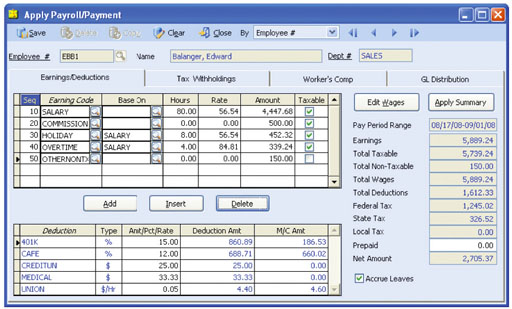

 |
 |
It is vital for a company to
have full control over its
payroll system to ensure
that it processes employee
compensation accurately and
quickly. With AccountMate’s
Payroll module, you can set
up records for salaried, hourly
and time card/piece work
employees, as well as Software
|
AccountMate 7 for LAN Instant Access to Employee Information
Users can drill down on the Employee number field caption for instant access to an employee
record. They can view or edit salary, W-4, earnings, paid leave benefits, dependents, deduction,
quarterly taxable earnings and payroll tax information. Users can also update the assigned state
and local tax codes, resident status, additional withholding amounts and the setting to override
system-calculated withholding taxes. This flexibility gives users the capacity to review and
update employee data before processing payroll.
 Apply Payroll—Payment
Additional State Tax Codes Can Be Set Up
Users can define up to three additional tax codes for each tax state. For each additional tax,
they can set up employee and employer tax rates and define a maximum wage base. This is
useful for setting up taxes that affect all employees in a state but are not hard-coded into the
system since they may not apply to all companies.
Manage Employee Hours and Pay
The Payroll module allows users to track each employee’s work hours through the use of earning
codes. These may be set up for regular work hours, overtime, holiday or leave time. They can also
represent earnings that are independent of work hours such as tips, commissions, bonuses and
fringe benefits. By assigning a department to each earning code, users can track departmental
accountability for employee work hours. The pay rate defined for an earning code is applied by
default to each employee who is assigned to a particular department allowing the standardization of
pay rates by department and work type. Users can overwrite these pay rates when setting up an
employee record. Finally, they can define whether an earning code is taxable.
Flexible Wage, Tax and Worker’s Compensation Expense Distribution
Users can allocate the expenses for employee wages, employer
payroll taxes and worker’s compensation claims to multiple GL
Account IDs and define a distribution percentage for each. This is
defined on each earning code, thereby offering maximum flexibility
in allocating payroll costs to the appropriate cost centers in the
organization.
Accrue, Track and Adjust Paid Leave
Users can accrue paid leave time for qualified employees.
Unlimited paid leave records can be set up for vacation, sick,
personal or any other paid leave benefits the company offers its
employees. Users can define the accrual hours, minimum hours
required to qualify for accrual, and the maximum leave hours that
can be accrued and carried over into another year. These settings
are applied based on the assigned employee tier. Accrual may be
done at the start of the year or each time payroll is processed.
Users can record the use of an employee’s leave time when
processing payroll. And when the employee leaves the company,
the unused leave time can either be converted to cash or the
remaining balance can be cancelled.
Unlimited Deductions with Option for Employer Matching/Contribution
Users can set up an unlimited number of deductions, and then
apply any number of them to each employee. They can indicate
whether a deduction is to be withheld as a fixed amount per
pay period, a percentage of earnings or a fixed rate per hour
worked. A user can also define whether the deduction will be
based on gross or net pay, set a maximum deduction per payroll
transaction and set an annual deduction limit. Alternatively, users
can apply deduction amounts and annual limits based on the
employee’s age. They can also indicate whether a deduction is
to reduce federal, state or local taxable wages, as in the case
of 401(k) plan contributions. If applicable, users can also set
parameters for calculating employer matching and/or contributions
for these deductions. They can customize each deduction for
each employee and overwrite the deduction rates when
processing payroll.
Calculate Liability for Worker’s Compensation
AccountMate provides users the means to calculate and track
liability for worker’s compensation. They can set up an unlimited
number of worker’s compensation codes and worker’s
compensation groups. For each combination of worker’s
compensation code and group, users can enter the rate and
annual limit set by each state, as well as the experience factor
that applies to the company. They can apply these worker’s
compensation codes and groups to earning codes and employee
records to facilitate calculation of worker’s compensation liability
on qualified employee payroll transactions.
Apply Payroll Automatically or Manually
The automatic application of payroll is a fast and easy way
to accrue payroll for a range of employees or independent
contractors. If users want the flexibility to review, amend,
apply or skip application of payroll for certain employees,
they have the option to apply payroll manually. Regardless
of the method used, the system calculates earnings, deductions,
employer matching/contributions, paid leave accruals, worker’s
compensation and payroll tax amounts based on the data and
settings defined for each employee.
Record Time Card, Piece Work or Additional Payment Transactions
Users can enter time card information using the earning code
records that exist in the system, thereby saving valuable time.
They can also record piece work transactions for employees who
are paid based on their output rather than the amount of time
worked. Finally, users can record bonuses, commissions, fringe
benefits, cash conversion of unused leave time and other similar
employee payments. Time card, piece work and additional
payment records are processed using the Apply Payroll/Payment
function for calculation of the corresponding deductions, employer
matching/contribution, paid leave accrual, worker’s compensation
liability and payroll taxes.
Support 1099 Payments
The Payroll module supports 1099 payments to independent
contractors and tracks these payments for generation of 1099
reports, including printing on 1099-Misc forms. Users can print
1099-Misc forms for the prior or current tax year.
Alerts Help Prevent Duplication of Payment
The system alerts users when a time card has been recorded for
an employee during the day. It also alerts them if there are unpaid
applied payroll records for the employee for whom they are
applying payroll. Users can review the amounts applied for
payment to validate whether the transaction being processed
duplicates an existing applied payroll/payment record.
Record Payroll After-the-Fact
The Post After-the-Fact Payroll function allows users to record
payroll checks generated outside the system and the related
earnings, deductions, and payroll taxes. This is useful for
companies that implement the Payroll system halfway through
the year but need complete payroll data to generate accurate
W-2 and other tax reports by the year’s end.
Support Direct Payroll Deposits and EFTPS Payments
The system supports direct deposit of employee payroll checks
using either the National Payment Corporation or the Automated
Clearing House network. For each employee, users can define
up to three direct deposit bank accounts.
AccountMate also supports the electronic deposit of Form 940 and 941 federal payroll taxes via the Electronic Federal Tax Payment System. This enables users to remit payroll taxes directly to the IRS and avoid having to make trips to the bank. lexible Check Printing and Recording Options
Print checks on either pre-printed or blank check stock. Users
can customize the order in which the bank routing number,
account number and check number are printed using the
Microline font that comes standard with AccountMate. They
can also maintain specimen signatures and a company logo
for automatic printing onto blank check stock. In case users run
into print job problems, they can reprint checks using the same
check numbers without voiding the related check records in the
system. In addition, they can choose to print the employee’s social
security number on check stubs using an encryption format that
has been defined.
The system also supports recording of handwritten checks to pay off existing applied payroll records. This flexibility makes it easy to record the issuance of payroll checks outside the Payroll system. Allow Recalculation of FUTA/SUTA Amounts
Users can recalculate the company’s FUTA and SUTA liabilities.
This feature allows users to quickly adjust to changes in FUTA
and SUTA tax mandates (i.e. rates or maximum wages) that may
occur after paychecks are issued.
Integration with General Ledger, Accounts Payable and Bank Reconciliation Modules
Other Features
AccountMate Software Corporation © AccountMate Software Corporation. All rights reserved. Reproduction in whole or in part without permission is prohibited. The capabilities, Software Requirements and/or compatibility described herein are subject to change without notice. Contact AccountMate or Authorized AccountMate Solution Provider for current information. |
||||||||||||||||||||||||||||||||||||||||||